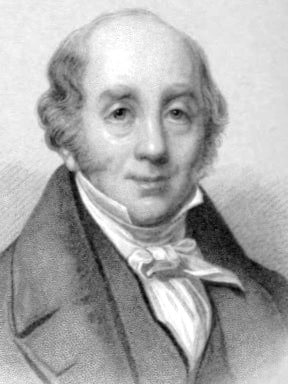Abraham Colles

Abraham Colles (1773-1843) was an Irish surgeon and anatomist.
One of the greatest of the Irish surgeons. He excelled as a clinician, as a teacher, and an anatomist. Eponymously remembered by a fracture, a fascia, a law and a ligament.
Inspired after stumbling upon an anatomy book swept away by flooding from the local doctor. Most important work – Treatise on Surgical Anatomy, (Dublin, 1811) with significant pathological descriptions still in use today
Eponymously associated with the Colles Fracture – describing the deformity 80 years prior to the discovery of x-ray. Colles advocated use of tin splints to stabilise fracture following closed reduction and the use of mercury in treatment of syphilis.
…for be assured, that no man can know his own profession perfectly who knows nothing else
Colles 1811
Biography
- Born on July 23, 1773, in Millmount near Kilkenny
- 1795 – Bachelor of Arts, Trinity College Dublin. Given a license to practice by the college of surgeons.
- 1797 – MD, Edinburgh Medical School
- 1802 – President of the Royal College of Surgeons in Ireland (age 29)
- 1804 – Professor of Surgery and Professor of Anatomy and Physiology, Royal College of Surgeons in Ireland
- 1838 – Co-founded the Pathological Society of Dublin along with Smith, Graves, Corrigan and Stokes
- Died on November 16, 1843
Medical Eponyms
Colles fracture (1814)
Extra-articular fracture of the distal radius with dorsal angulation of the distal fragment. Frequently associated with an ulna styloid fracture and volar angulation of the fracture apex
1705 – Frenchmen Jean-Louis Petit and Claude Pouteau (1760) both independently suggested (…prior to Colles) that some carpal dislocations were in fact fractures of the end of the radius. Pouteau hypothesised the characteristic dorsal angulation of the distal fragment.
1814 – Colles description of distal radius fractures occurred prior to X-ray. He contradicted previous belief that these injuries were dislocations of the carpus from the wrist. Colles further described early closed reduction technique and tin splinting immobilisation.
This fracture takes place at about an inch and a half * above the carpal extremity of the radius, and exhibits the following appearances. The posterior surface of the limb presents a considerable deformity; for a depression is seen in the fore-arm, about an inch and a half above the end of this bone, while a considerable swelling occupies the wrist and metacarpus. Indeed, the carpus and base of metarcarpus appear to be thrown backward so much, as on first view to excite a suspicion that the carpus has been dislocated forward.
Colles, 1814:183
1847 – Thanks to Smith, Colles received the distinction of having his name attached to the most common fracture of the wrist.
In this country, the name of an eminent surgeon, lately deceased, has been associated with this injury; we know it here as Colles’s Fracture of the Radius.
Smith 1847;129
Smith was well aware of Pouteau’s work and even referred to Pouteau’s statement regarding Colles’ fracture that:
…there is no fracture the existence of which it is more easy to tell at a single coup d’oeil (look of the eye)
Smith 1847;140
Colles law (1837)
Colles believed his most important work was Practical Observations on Venereal Disease, and on the Use of Mercury. He described the relationship between the syphilitic mother and child now known as Colles law.
A child born to a mother who has no signs of venereal symptoms, and presents with this disease at the age of a few weeks, will infect the healthiest nursemaid, but not its mother.
Colles 1837
Unfortunately, his conclusion was wrong, as the mother would already have been infected with syphillis but not manifesting clinical symptoms at birth
Other medical eponyms
- Colles fascia (1811) – deep layer of the superficial perineal fascia. The middle fascia of the urogenital triangle the attachments of which served to confine within strict limits extravasation of urine from a ruptured urethra
- Colles Space (1811) – Space located below the perineal fascia and containing the transverse muscles of the perineum, ischiocavernosus and bulbocavernosus, the scrotal or labial nerves and vessels and the bulbar portion of the urethra.
- Colles ligament (1811) – small triangular fascia that springs from the pubic crest and ilio-pectineal line and passes upwards and inwards towards the linea alba under cover of the internal pillar of the external abdominal ring
The study of anatomy too generally ends at that point where it begins to be useful.
Colles 1820
Controversies
Robert William Smith (of Smith fracture fame) had a reputation as a pathologist. Colles requested that Smith be called upon to perform his own autopsy. The autopsy was performed and later published by later published by William Stokes as ‘Observations on the Case of the Late Abraham Colles‘
Hayden GT in 1837, referenced Colles as completing the first surgery for an axillary aneurysm (performed by ligating the first part of the subclavian artery), however the patient died 13 days later. Colles blamed the patient moving about:
The perverseness and obstinacy of my patient, in this respect, were most deplorable, for she would, in despite all our entreaties and warnings, move about, perfectly reckless of consequences.
Colles A. A treatise on surgical anatomy. 1811:13
Abraham Colles was renowned for his clinical teaching. He was Professor of Surgery at the Royal College of Surgeons in Ireland for 32 years. He believed that a dynamic and broad ranging education was crucial to creating capable surgeons.
You may think, that if the time required for those general studies were devoted solely to the pursuits of your own particular profession, it would be more wisely and profitably employed. But this opinion is equally narrow and unfounded: for be assured, that no man can know his own profession perfectly who knows nothing else; and that he who aspires to eminence in any particular science must first acquire the habit of philosophizing on matters of science in general.
Colles A. A treatise on surgical anatomy. 1811:13
Colles’ impact was such that he was offered a baronetcy by The British Government. However due to his Irish Nationalist political views he refused this offer.
Mr Colles won his way to eminence by means which are, to some extent, within the reach of all. He may be said to have wrested success from the hands of adverse fortune by his energy and indomitable perseverance. His family and descendants may point with pride to the unadorned name of Abraham Colles, and boast that they are sprung from one who merited a title, but declined it.
McDonnell R; 1881: 3
Major Publications
- Colles A. A treatise on surgical anatomy. Dublin: Gilbert and Hodges. 1811
- Colles A. On the fracture of the carpal extremity of the radius. The Edinburgh medical and surgical journal. 1814;10:182-186. [Clin Orthop Relat Res. 2006;445:5-7. PMID 16601406] [Colles fracture]
- Colles A. On the Operation of tying the Subclavian Artery. The Edinburgh medical and surgical journal. 1815; 11: 1-25.
- Colles A. A treatise on surgical anatomy. 1820
- Colles A. Practical observations on the venereal disease, and on the use of mercury. London: The New Sydenham Society. 1837
References
Biography
- Memoir of A. Colles. The Dublin University Magazine 1844;23:687-690
- McDonnell R. Selections from the works of Abraham Colles. 1881
- Jones AR. Abraham Colles. The Bone & Joint Journal. 1950; 32: 126-130
- Fallon, M. Abraham Colles 1773-1843, Heinemann. 1972.
- Pearson E. The complete doctor: Abraham Colles. RCSI People. 2008;1(1):1
- Fresquet JL. Abraham Colles (1773-1843). Historia de la Medicina.
- Bibliography. Colles, Abraham 1773-1843. WorldCat Identities
Eponymous terms
- Hayden GT. Mr Hayden’s case of aneurism. Lancet 7 October 1837; 29,736:47-50.
- Peltier LF. Eponymic fractures: Abraham Colles and Colles’ fracture. Surgery. 1954 Feb;35(2):322-8
- Peltier LF. Six eponymic fractures. Bull Med Libr Assoc. 1960 Jul;48(3):345-51.
Eponym
the person behind the name
Dr Ronan McKenna, MB BCh BAO at National University of Ireland Galway. Living in Australia with plans for a future in Emergency Medicine. A keen interest in Medical History, Wilderness Medicine and Sport.
BA MA (Oxon) MBChB (Edin) FACEM FFSEM. Emergency physician, Sir Charles Gairdner Hospital. Passion for rugby; medical history; medical education; and asynchronous learning #FOAMed evangelist. Co-founder and CTO of Life in the Fast lane | On Call: Principles and Protocol 4e| Eponyms | Books |

